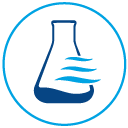
How to Understand Your Stormwater Sampling Lab Report
1. Introduction to Stormwater Testing
If you have had your stormwater tested by a laboratory you have received or will be receiving a stormwater sampling lab report. This report is not easy to understand if you haven’t done this before and even if you have it is challenging. But knowing and understanding your results is extremely important. So, we want to provide you with a few insights into how to understand your lab report.
The process you have been on has been following your Stormwater Pollution Prevention Plan (SWPPP) throughout and it will be important that you first check to see that the field ID on your report matches your site map in your SWPPP and the collected samples you sent to the lab.
Next you can check that the date and time sampled in the lab report matches the date and time you collected the sample(s). Finally, you should check the date the stormwater sample was received by the lab because some consultants have held onto stormwater samples too long and have exceeded hold times, a potential invalidation of the results
These quick checks are a good habit to get into for ongoing testing because they ensure your results are consistent and accurate.
2. Measuring Pollutants in Stormwater
The Event Mean Concentration (EMC), also called the volume-weighted (or flow-weighted) pollutant concentration, provides you with the most comprehensive water quality lab report data numbers for stormwater pollutant discharges. The EMC is defined as the total pollutant mass discharged in the stormwater divided by the total runoff volume for the storm event, and is measured at a specific measurement point:
C is the pollutant concentration, Q is the flow rate, t is time, and Td is the storm duration.
Composite sampling is the most accurate method and involves collecting multiple samples then combining them to find a measure of the overall stormwater condition. There are multiple techniques of sample compositing and they are dependent on the number of samples collected, whether they are weighted by time or stormwater volume, and if they are collected manually or automatically. In general the more samples used in the compositing, the closer the resulting sample is to the EMC of the pollutants in the stormwater
3. What does a Stormwater Sampling lab report contain?
Your Water Quality Lab Report will tell you if any of the pollutants listed in your SWPPP were found, in what concentrations and whether any of those concentrations exceed the Action Limit. If any exceed the Action Limit the results will require mitigation efforts on your property to remove those contaminants.
There may be quite a bit of information in your report that involves levels concerning many various contaminants, and your results will likely include a few symbols and decimal numbers that don’t mean anything to you. This is where you must use whatever information the lab has supplied for you and you should never hesitate to contact the lab for interpretation and clarification.
4. Understand parameters in a Stormwater Sampling lab report
Breaking down a number as an example, let’s say the analytical result for O&G for your stormwater sample is “1.98 J”. What does that mean? The 1.98 is the measurement level of the result. For O&G this is typically milligrams per liter (mg/L). So the next question is, what does the “J” included with the result mean? In this case the analytical laboratory has flagged (or J-flagged) the value because it is being reported as an estimate.
The reason for an estimate in a water quality lab report is that laboratories have analytical equipment capable of measuring concentrations in stormwater samples down to a certain limit. This limit of measurement is called the Reporting Limit (RL) or the Practical Quantitation Limit (PQL), depending on the laboratory. It is the lowest limit possible for which a laboratory believes they can provide an accurate result.
If your water quality lab report says “go as low as you can go” it means that as a client you must ask your lab to measure and report to the Method Detection Limit (MDL). The MDL is the lowest possible reading a laboratory can make using this analytical method (1.7 mg/L for O&G) . But since the laboratory isn’t completely confident in measurements made between their RL and the MDL, they estimate the value (such as 1.98 mg/L) and flag it as an estimate.
For this reason it is important to write on your Chain of Custody (COC) “Report to MDL”, because many times the laboratory defaults to just reporting to the RL. Without specifying “Report to MDL” if your water quality lab report result says ND, it is possible you still have a result above the MDL but below the RL. Additionally, asking for results to be reported to the MDL doesn’t cost any extra!
5. Conclusion
When looking for a lab, Torrent Laboratory offers a full array of stormwater testing to help you determine if you are in compliance with local, state and national standards for your stormwater runoff. Our facilities in California can help you gather samples of stormwater runoff from your facilities, land and parking lot. You simply ship, deliver or mail your collected samples to our lab. Our technicians and engineers will test for any or all pollutants and hazardous chemicals.
We will determine levels of heavy metals and we have the top of the line pesticide residue testing. Also included in our array of testing options are water testing for PFOA and PFOS as well as polyaromatic hydrocarbons tests (PAHS). These tests detect the presence of dangerous chemicals that must be mitigated for the protection of all life on your site.
Torrent is your full service Laboratory with the highest state (CA ELAP) and federal (DoD ELAP and DOE ELAP) certifications to meet all of your stormwater testing needs.







